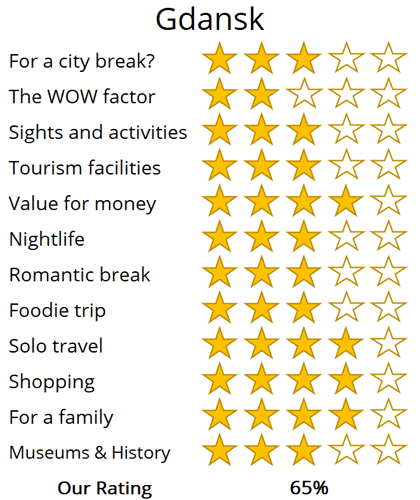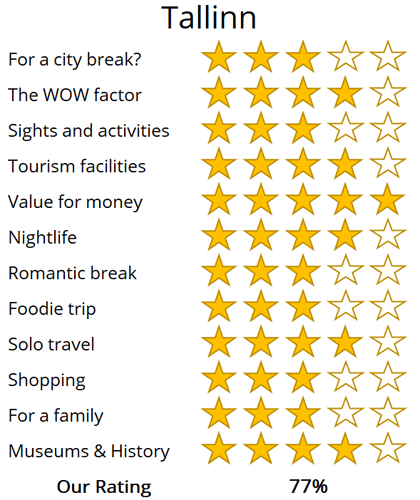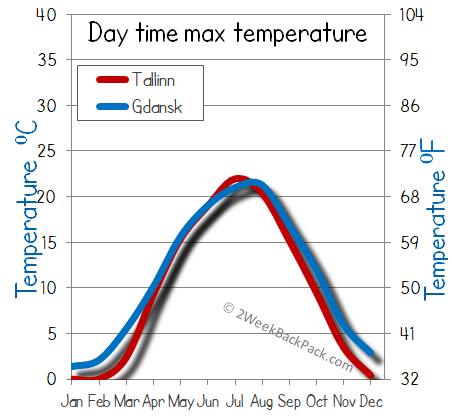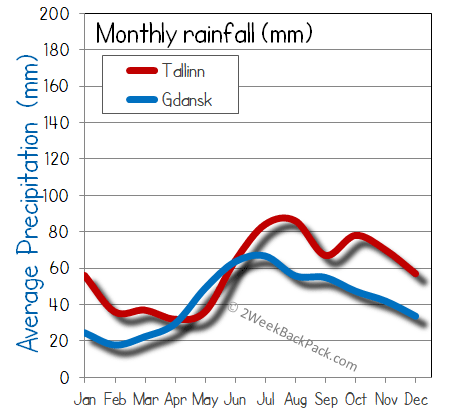WhereToGoForMyHoliday.com
The best destination comparison site!
WhereToGoForMyHoliday.com
The best destination comparison site!
Gdansk or Tallinn a vs city comparison and travel guide
Gdansk and Tallinn both offer unique and enticing experiences, but which one should you choose for your city break or holiday?
We understand your dilemma. There is an abundance of travel guides for both cities, but few actually comparing them, and advising you which is the better for your trip.
This article will provide our unbiased and independent views of Tallinn and Gdansk, hopefully making your choice that little easier.
The article is structured into several sections, each of which can be directly accessed through the following links:
• Introduction to the cities
• Scores and ratings
• Which one should I, friends, or family visit?
• When to visit and weather
• Who is the city suited for?
• The perfect 48hours (with map)
• Tourism details (where to stay? airport details?)
Introduction to Gdansk and Tallinn
Salt-washed, industrial-chic and filled with hipsters, Gdansk is one of the most happening cities in Poland. It sits on the edge of the Baltic Sea, proudly showcasing its merchant guilds and mansions, a leftover from the years when this was one of the richest ports in the Hanseatic League.
Like most Polish cities, the focal point is an immersive Old Town (also called the Main City) that beats with life and cafés and boutique shops.
Around that's a newer city where the remnants of Communist rule still pop up in the tenement blocks and the famous dockyards where the Solidarity movement heralded the beginning of the end for the USSR in the 1980s.
On top of all the architecture and culture is a vibey bar scene that's powered by a hefty student population. There are clubs and pubs everywhere, from the open-air boats on the quaysides to the hidden basement bars in the old quarter.
What's more, Gdansk is the gateway to the Polish coast, with Hel Peninsular and its oat-topped dunes close by, or the resort town of Sopot only a short train ride away.
You could be forgiven for thinking you'd been plucked from the 21st century and dropped back in the 1300s when you step foot in Old Town Tallinn. Cobblestone lanes braid their way through stooped taverns with drooping roofs, chimney stacks, and grey stone keeps that echo The Lord of the Rings.
Aged Toompea Hill is the anchor of it all, erupting above the capital with its muscular castles and onion-domed churches. Below, the Lower Town buzzes with energy, pitting beer bars next to Baltic eateries and church steeples.
Tallinn has also established itself as one of Europe's most cutting-edge cities in recent years. It's a digital powerhouse with start-ups and creative agencies galore. They fuel areas like Kalamaja, which is all roaster coffee joints in Soviet tenements and funky bars in rundown prisons that spill into the Baltic Sea, proving it's not all about the history in these parts…
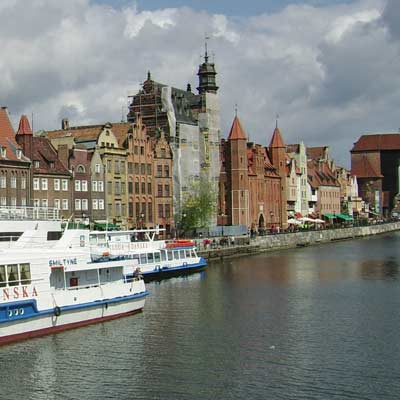
The scenic Długa waterfront in Gdansk
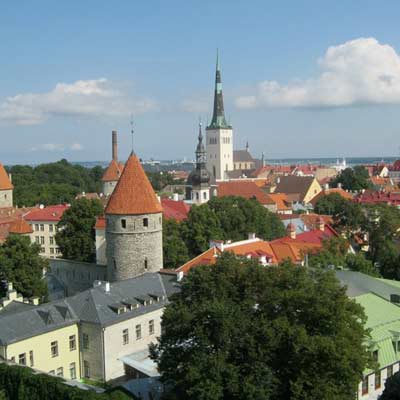
Medieval towers dominate the skyline of central Tallin
Gdansk vs Tallinn: City Ratings
Summary
Where would I journey for a personal escape?
Tallinn
Where would I send my parents for a memorable visit?
Tallinn
Where's the ideal destination for my adventurous 19-year-old cousin?
Tallinn
Where should my food-obsessed friend indulge their culinary passions?
Tallinn
Note: The above comparisons are weather-independent and are based on travel during the most opportune times of the year. Details about the ideal travel seasons are elaborated upon later in this article.
In the sections that follow, you'll find a comprehensive comparison between these two fascinating cities. This includes recommendations on the duration of stay, the best times to visit, and tailored 48-hour itineraries for each city.
The final segment delves into practicalities for your travels, such as the best airport to fly into, the optimal districts for your accommodation, and insider tips, for when you come to explore the city.
We hope that you find all of this information useful, in planning your next exciting trip!
Destination details
How long to spend each city?
Tallinn might not be the biggest European capital, but it's a place that always seems to have another secret up its sleeve. Yes, two days might be enough to see the old city walls, wander Toompea Hill and sample the delights of the Estonian kitchen, but there's certainly enough to fill trips of four, five or even more nights.
Have a think about what you're after from your travels and then decide. If you're eager to squeeze in a few nights on the town (a good shout, as Tallinn is downright hedonistic), daytrips to the wonderful forests and coast swamps of Lahemaa, and a couple of the museums, you'll probably want to give yourself some extra time.
Gdansk can be done in just a couple of days, but don't expect that to be enough to do everything. You'll likely want to linger longer, if only to beachcomb the Baltic coast, explore the other corners of the Tri-City (Gdansk is just one of three individual towns that are joined together), and sample as many of the cool hipster bars as you can.
Still, city breaks are very much doable here. Just 48 or 72 hours is ample for checking off the historic sights in the centre, the fascinating dockyards monuments, and to get a feel for the unique fusion of Slavic-Germanic architecture that abounds. Expect to do a lot of walking, though, and be ready to hop on inner-city trains and trams to get from A to B.
During the summertime, you could opt to do as thousands of Polish locals do and extend your Gdansk holiday to a week or two. That'll let you head out to the coast and the beaches. They can be surprisingly stunning, especially along the breezy Hel headland.
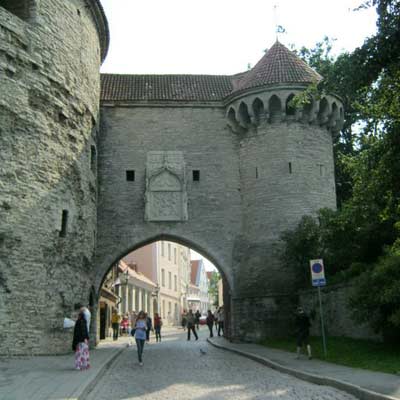
The Suur Rannavärav (Great Coastal Gate) protected Tallinn from seaward invasion
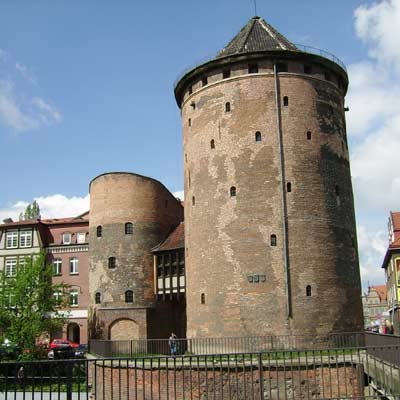
The Stągwie Mleczne was the ancient gateway to the southern side of Gdansk
Gdansk is surely at its best in the warmer months. Between May and September is when most travellers come. They get to enjoy all the al fresco bars along the old port. They can wander the Old Town without worrying (too much, at least) about rain. They can hit the open-air terraces to taste pierogi dumplings. The weather is a little milder than inland Poland thanks to the tempering effect of the Baltic Sea. Average highs in July are in the low 20s, but that's enough to bring crowds to the beaches of Sopot and the north coast.
The winter in Gdansk can be brutal. The Baltic magnetises icy storms and cold winds across the shoreline and the city. It's a time to get cosy in cute cafes and sip warm beers (yes, that's a thing here), but be certain to pack the thermal leggings and snow coats.
The summer is considered to be the finest time in the Tallinn. From around May onwards, the temperature picks up to the high teens and early 20s, there's more sun, and the days are longer. From June onwards, the travellers and the crowds come, lending a buzz to the bars of the Lower Town.
There's no question that Tallinn looks downright gorgeous under plumes of snow in the midwinter. Some say it's the most enchanting time of all, as the nights draw in and there's ice glinting like diamonds on the roofs of the old churches. On the main Town Hall Square, you'll also be able to enjoy the delights of the Tallinn Christmas Market from early December onwards – think handmade Estonian decorations, hot wine, and traditional pastries. Don't expect to be warm, though. The Baltic gets sub-zero and bitter winds all throughout the season.
If you're keen to go a little off the beaten path and discover somewhere laced with rich history and culture, Tallinn is beckoning. With more and more low-cost flights now serving the local airport, a trip to this north-eastern corner of the continent isn't the chore it once was.
So, anyone eager to ditch the mainstay cities of Western Europe is in luck. Adding to that is an Old Town that's been called the best-preserved medieval quarter in the world, so there's loads for fans of original architecture and atmospheric neighborhoods.
Being so far north means there's nothing like the warmth of the Med or southern Europe up in these reaches of the Baltic. Yes, the summer months can get hot and the sea is only a stone's throw from the city, but Tallinn is hardly a beach destination.
Also remember that this is a small capital by global standards. It's certainly not the pick for anyone on the hunt for a colossal, electrifying metropolis.
Gdansk has got loads going for it on the travel front. Melding enthralling medieval history with sobering tales of wartime and the proud trade union movement, it's a gem for those looking to unravel the history of Central-Eastern Europe. Shoppers get to delve into Amber shops galore – the city is hailed as one of the best places in the world to buy the glowing fossil. Hedonists get everything from basement bars to wild clubs in old bunkers that stay open all night. Sightseers need only look to the historic Old Town and its grand churches and squares.
Adding to all that, Gdansk has beaches. A quick train to Sopot will reveal one of the nicest in the region, with a long pier that juts out into the Baltic. A little further and you can get to Puck, which sits at the base of what is arguably Poland's finest length of coastline.
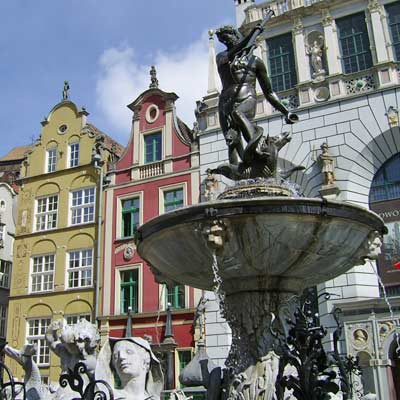
Neptune's Fountain in the historic centre of Gdansk
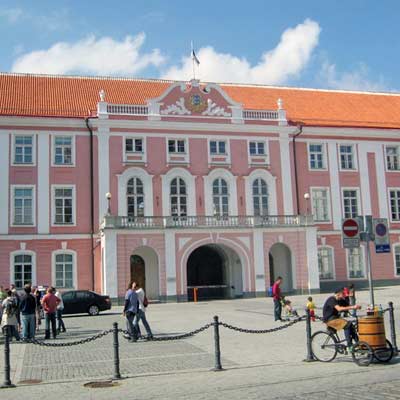
The Baroque wing of the Toompea Castle, is also the parliament building for Estonia
48hours in Tallinn
Wander the Lower Town, see Russian-style cathedrals, taste medieval broths in immersive eateries, gaze at the frothing Baltic waves, duck under ancient fortification walls – all that and more should be a part of any two-day itinerary for the Estonian capital…
Day 1: The Town Hall Square (Raekoja plats) at the very core of the city is always the perfect place to begin. Go there and the sightseeing will start immediately. The eponymous Town Hall itself is the main attraction. It's a beautiful 36-meter structure with a tower that's topped with the Old Thomas weathervane, now a symbol of the city. You're also at the perfect starting point to get lost in the Lower Town of Tallinn.
That's the largest part of the historic center, a UNESCO site, and the place where merchants and guilds would once have plied their trade. Viru Street is one not to miss within. It's a hubbub of shops and eateries, all leading to the handsome Viru Gate, which dates all the way back to the 14th century. A whisker to the north is the Hellemann Tower, offering travellers access to a high lookout point and a 200-metre stretch of the City Walls.
Once you're back on dry ground, delve into the Lower Town once again, going north via Pikk Street. At its end you'll emerge into the hipster area of Kalamaja. Boho coffee shops and Mexican eateries combine there, but the best way to spend the evening is in the block behind Tallinn's train station, where industrial-chic cocktail bars like St. Vitus mix up creative long drinks.
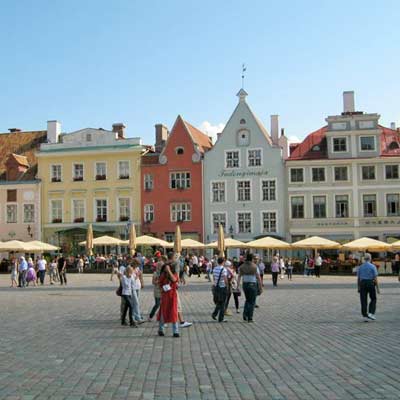
The Raekoja plats plaza is at the heart of Tallinn
Day 2: The early hours see you head above the Lower Town to Toompea Hill. Once the main keep and most fortified part of the historic city, it's still one of the most important postcodes in Estonia. On one side is the soaring Alexander Nevsky Cathedral, sporting onion domes and filigrees that evoke the Russian Empire.
On the other is St Mary's Cathedral, the oldest in the city. This is also the home of the modern Parliament of Estonia. On sunny days, the views across the historic town from Kohtuotsa are some of the best going, taking in the Paks Margareeta tower in the distance and Town Hall Square below.
Descend from Toompea and go back to the centre to find the immersive tavern of III Draakon. A fun-filled character pub, it's got food that mimics the diet of the 1400s and curt service to match. As evening draws in, pinpoint the nightlife hubs of Rataskaevu and Voorimehe for something a little hedonistic!
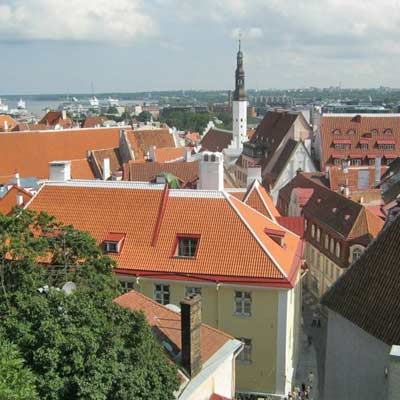
The view over the historic centre of Tallin
48hours in Gdansk
Gdansk has big-name sights like the iconic dockyards and its Old Town. But it also has secrets up its millennia-old sleeve. This 48-hour itinerary covers both, with a little bit of partying and beachside living thrown in for good measure…
The interactive map below shows a suggested route for the 48 hours in Gdansk, with day 1 highlighted in green and day two in yellow.
Day 1: Make for Cafe Libertas for breakfast. It's a popular spot with fruit bowls and artisan coffee that will fuel you up right in the heart of the Old Town. Stepping outside the door, you'll find quaint Chlebnicka street, which you can stroll between grand townhouses with Flemish-inspired façades.
At one end is Chlebnicka Gate, still flaunting its original medieval crest from 1450. Beyond is the riverside and the iconic Żuraw Crane. Now a branch of the National Maritime Museum, it's a great detour to make if you want to learn all about the history of shipbuilding in Gdansk.
Delve back into the maze of streets to the west and try to find the St. Mary's Church. It shouldn't be difficult – it's among the three largest brick-built churches on the planet! Past that is bustling Długa. The main drag of the city, it's awash with amber shops, bars, eateries and more.
Stop to sample some pierogi dumplings or grab a beer, and then move on to lovely Long Market square. That's where the famous statue of Neptune beckons, hemmed in by pastel-painted guilds. As evening arrives, return to Długa or Piwna street for basement bars that gush with vodka and cheap beer.
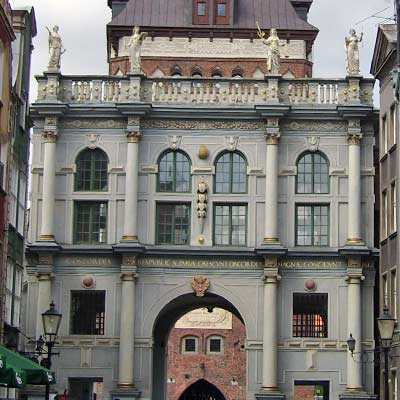
The Złota Brama (Golden Gate) is lined with figures depicting the qualities of the ideal citizen
Day 2: Morning of Day 2 takes you out to the legendary Gdansk Shipyards. If you haven't heard of these already, then buckle in for a history lesson in the fall of Communism. It was here, in 1980, that the powerful Solidarity movement first took route under the leadership of Lech Wałęsa. It would go on to fuel revolutions across the Eastern Bloc, which finished with the fall of the Berlin Wall and the end of Russian dominion in Europe.
There's nowhere better to uncover all that than at the European Solidarity Centre. A visit is likely to take a few hours, especially if you want to drop by the striking Monument to the Fallen Shipyard Workers of 1970 next door. For the afternoon, it's time to explore the Tri-City.
That means hopping on the SKM railway line from Gdańsk Główny. The ride to Sopot is only 15 minutes. It takes you to a lively resort area that's positively brimming with bars and eateries. It's also on the beach, so you might want to spend the evening here, moving between the music venues to famous Sopot Pier.

The European Solidarity Centre commemorates the Polish civil resistance and trade union which began in the Polish shipyards and ultimately led to the collapse of the communism in the USSR

Sopot has a beautiful beach and is an enjoyable destination during the summer season
Tallinn Airport is small, but it's served by low-cost carriers coming in from Scandinavia, Russia, and Western Europe. It's only a few miles from the Old Town, and the trip can be done on bus number 2 or with a private taxi – expect to pay in the region of €7-11 for that. Other travellers might come across the Baltic on ferries from Helsinki. They cost about €20 and go several times throughout the day from the port in Finland.
For hotels, the ideal location is the Lower Town. Generally speaking, the closer you get to Town Hall Square, the pricier the establishments become. But you might not even want to be there – it's buzzy and loud. The streets further north and east are laced with other B&Bs and even hostels and are still within walking distance of the monuments. The areas of Tonismagi and Tatari are good alternatives if you're really looking to keep costs low.
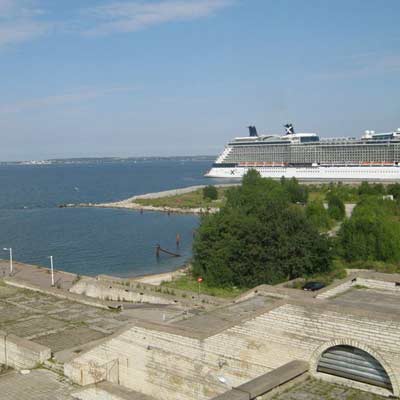
The ferry terminal in Tallinn
Tallinn is a very safe place to travel. It's got low crime rates, and, aside from the ubiquitous pickpockets and taxi scammers, there's rarely any serious issues. Some people have reported extortion scams in nightclubs, but that tends to be limited to the more unsavoury establishments that we think it's best to avoid anyway.
Tallinn is pretty compact and small for a European capital. It's long since burst the seams of its old core, but most of the main sights, bars, pubs, cafés, and museums are still hemmed in by the medieval walls. That means you'll usually be able to walk pretty much anywhere you want. Just be wary of cyclists in the narrow Lower Town streets and icy cobbles in the winter months. Both can be dangers.
Getting to Gdansk by plane is easy because of the countless short-haul and low-cost carriers that now fly into the local Lech Wałęsa Airport. A mere nine miles outside of the centre, you can get to the terminals on the 210 bus from the main train station. There are often problems with scam taxi fares to and from the airport, so always agree a rough price beforehand (the normal rate is between 60-80 PLN).
Gdansk's Main City is a joy to walk. The streets of Długa and the quays are all connected by loads of hidden alleys and paths. It might pay to have a tourist map at hand because getting lost is almost inevitable if it's your first time in town.
To travel to the beaches, the shipyards, and Sopot, you'll need to make use of the trams and inter-city SKM trains. The former cost 3.2 PLN per ride. Tickets are available from vending machines at most stations. Be sure to validate as you board.
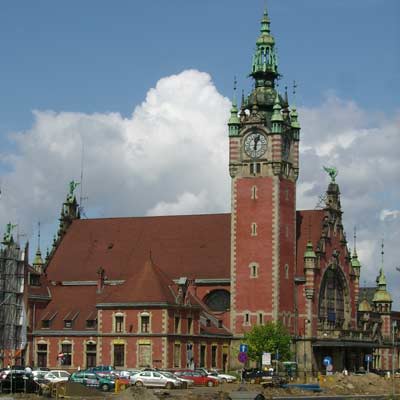
Gdansk Glowny - the main train station of Gdansk
The best location for a hotel in Gdansk is certainly in the Old Town area. There, you'll get boutique lodgings and stylish aparthotels set in centuries-old buildings. An alternative for those who favour beaches and nightlife would be to bed down in Sopot, where resort hotels with swimming pools and stylish restaurants are the norm.
Gdansk is among the most liberal and welcoming of Polish cities. It's got a vibrant LGBT scene and incidents of racism and crime are relatively rare. Still, there are still tensions in Poland and it's wise to be on your guard, especially if out at night in the bars of the Old Town.
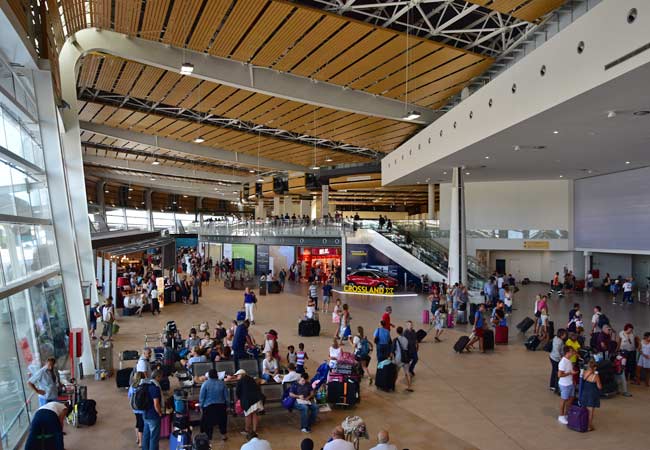
oh we were stuck in the airport!

Copenhagen was a bit expensive...

All we did was drink beer in Brussels...
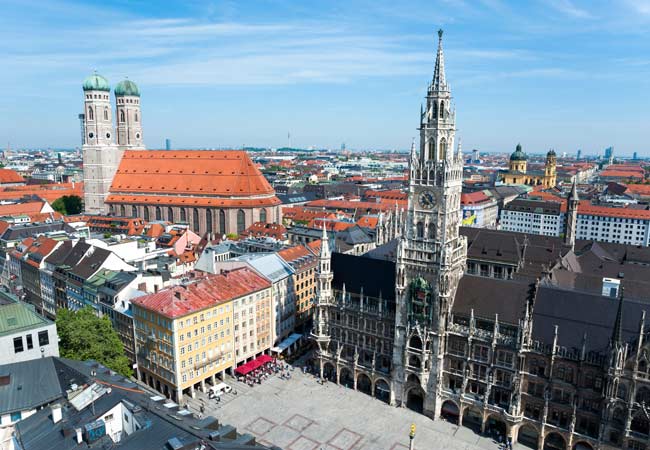
Muncih was crazy

And we got so burnt!
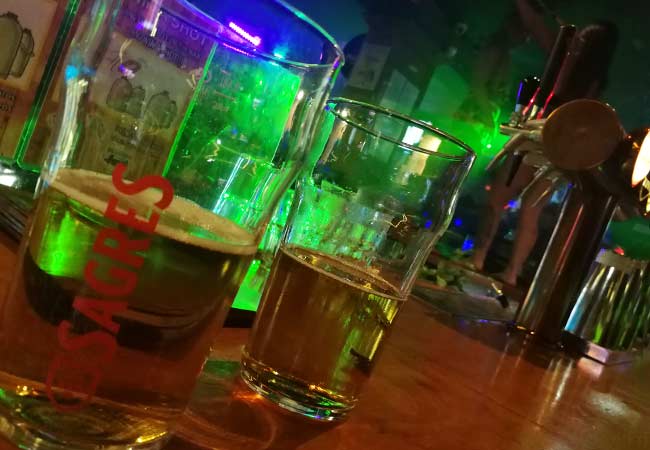
Remeber that night in Rome

oh we were stuck in the airport
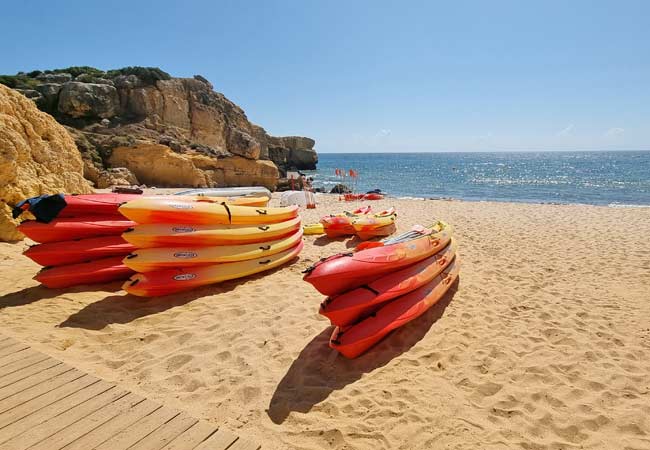
So much fun kayaking

Berlin and that group from Austria!

There was such a view from that church

And we got so burnt!

Munich was eventful, wasn't it!

Such a view from that cathedral in Florence
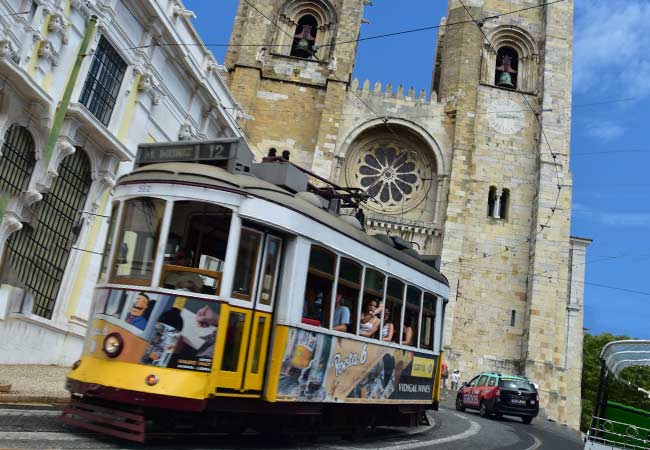
Lisbon was such so much fun

Last summer was so much fun .... x

Remeber that night in Rome

Lisbon was such so much fun

Such a view from that cathedral in Florence

Munich was eventful, wasn't it!

And we got so burnt!

Remeber that night in Rome

All we did was drink beer in Brussels...

Berlin and that group from Austria!

Can't wait to go back to Dubrovnik

Remember that boat ride in Prague

Copenhagen was a bit expensive...
